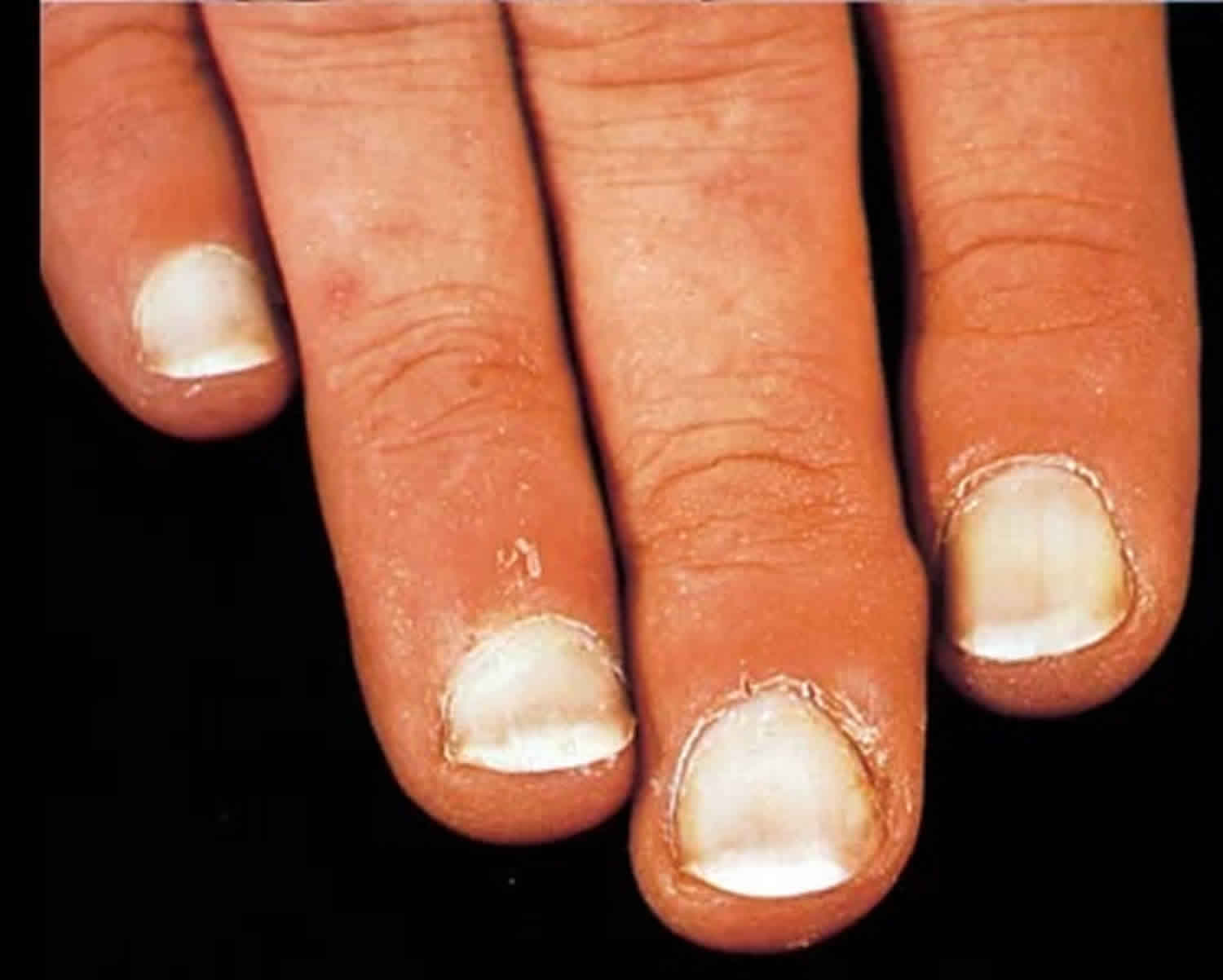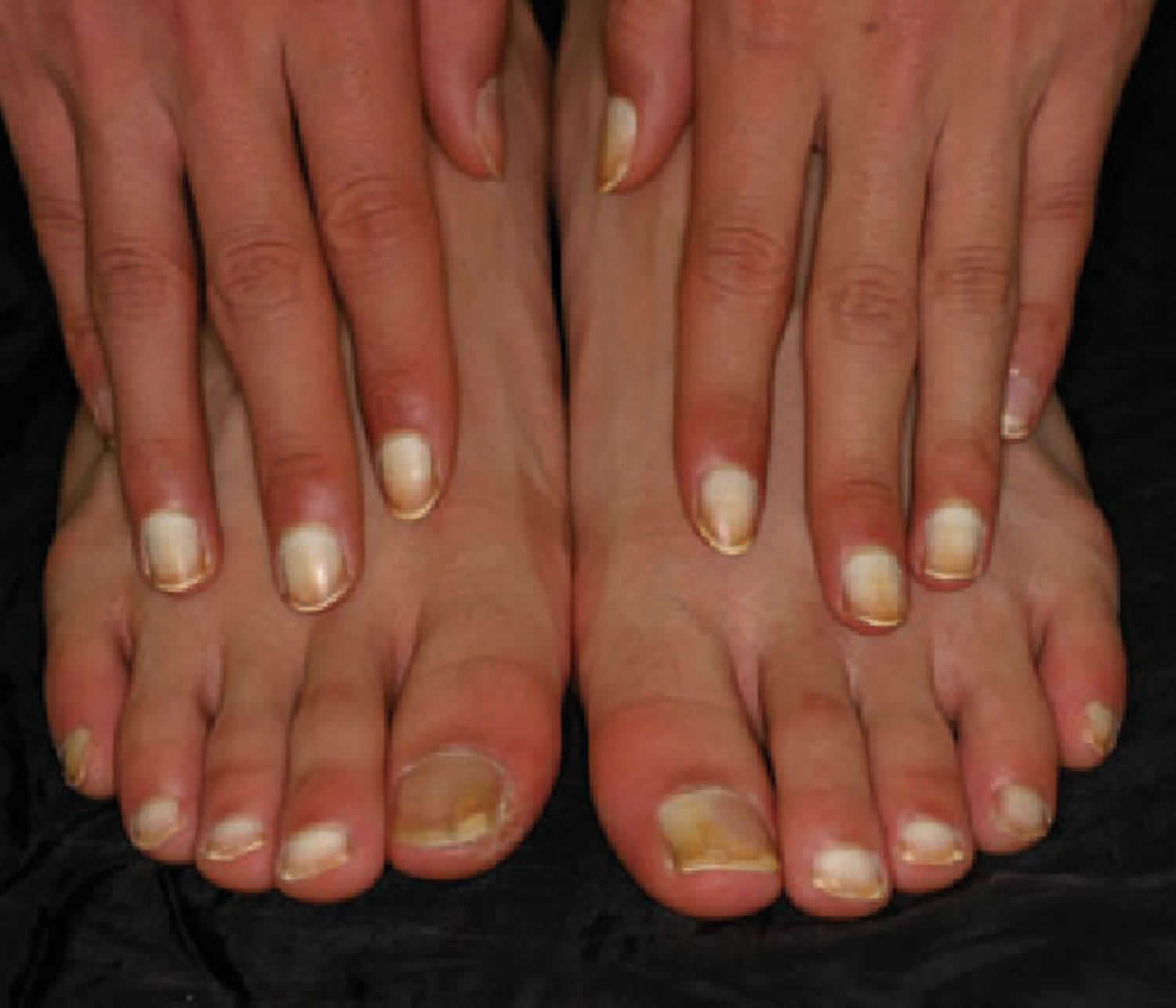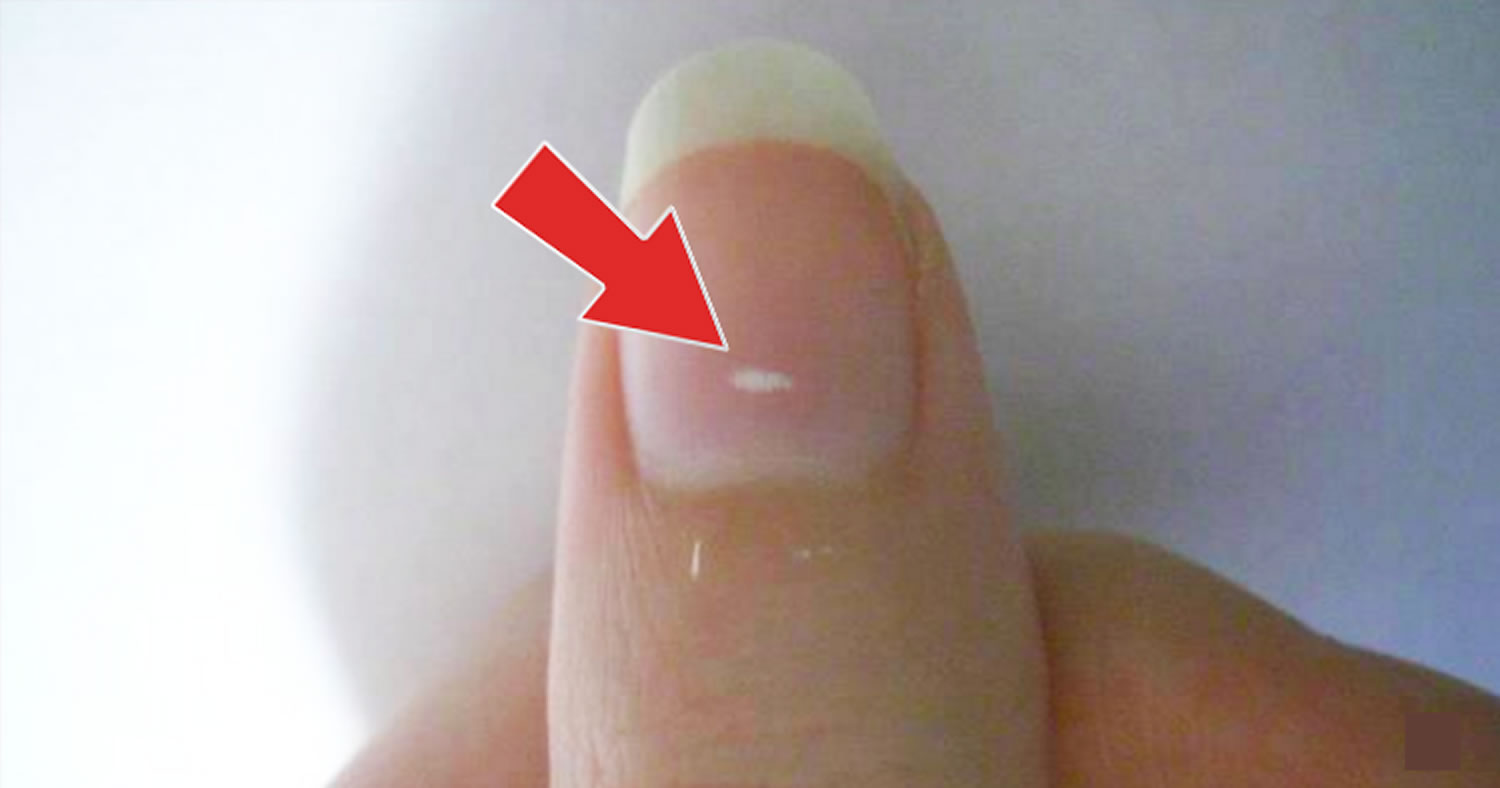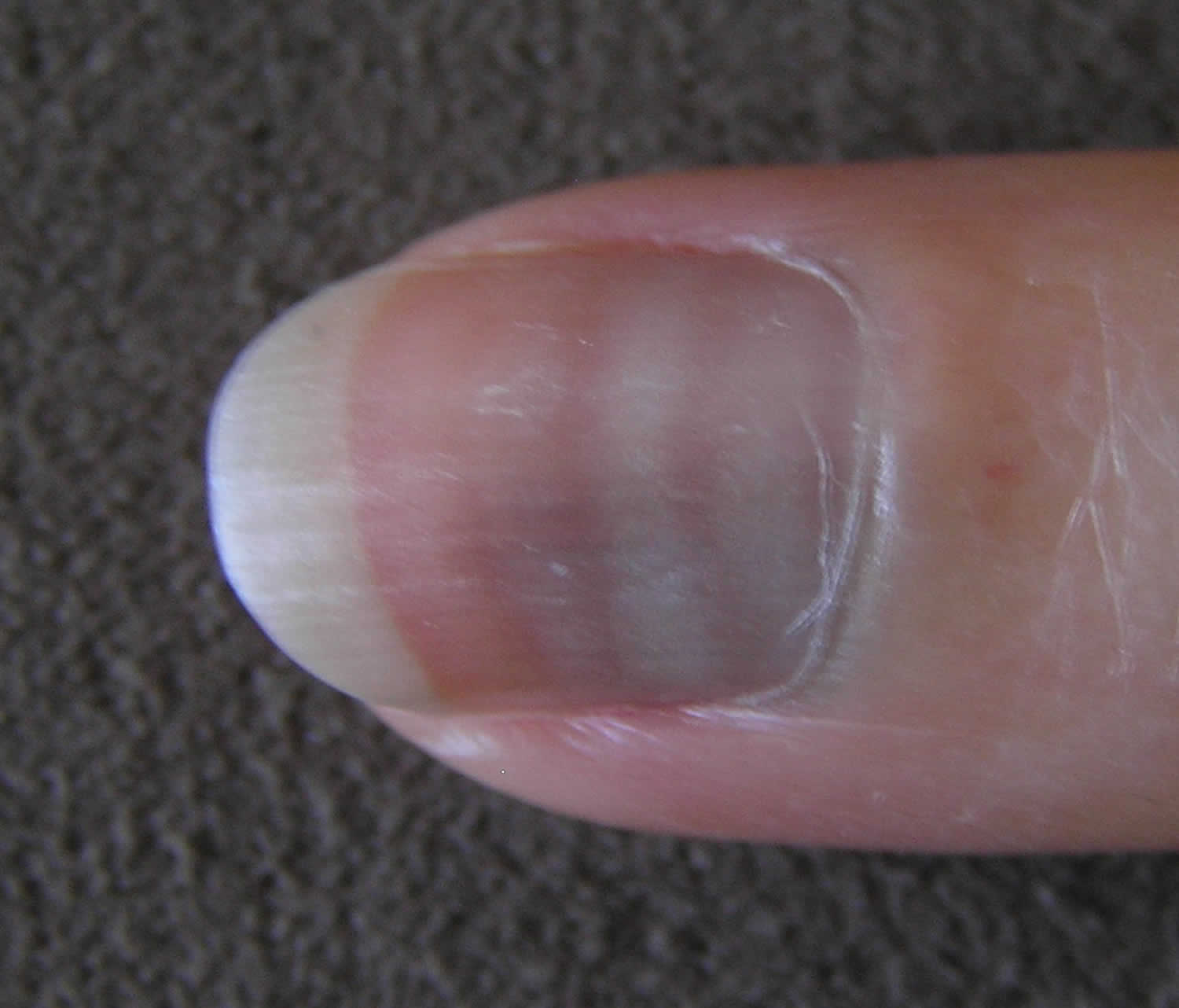Leukonychia
Leukonychia also called white nail syndrome, can occur with arsenic poisoning, heart disease, renal failure, pneumonia, or hypoalbuminemia. Leukonychia was first described by Mees in 1919, as an associated finding in arsenic intoxication 1. Leukonychia or white nail describes the appearance of one or more fingernails and/or toenails that are partially or completely white in color. Nails are generally a pinkish color. Leukonychia can affect anyone: males and females of any age or ethnicity.
Leukonychia can be either true leukonychia, with involvement of the nail plate, or pseudoleukonychia, caused by subungual and nailbed abnormalities 2.
The physiologic mechanism leading to whitening of the nail plate is not entirely clear. According to Newton’s theorem, a surface appears white when it reflects the radiation of visible light. This mechanism can be proposed in explaining leukonychia. Because true leuconychia is thought to be due to abnormal matrix keratinization, with persistent parakeratosis and keratohyaline granules in the nail plate, parakeratosis and dissociation of the keratin bundles may play a role in the modification of the solar light reflection by the ungueal plates.
Leukonychia may be acquired or inherited 2. Acquired leukonychia is frequently associated with trauma, drugs such as chemotherapeutic agents 3, systemic or local infections—such as typhoid fever, hepatic cirrhosis, ulcerative colitis or leprosy, hypocalcaemia, and, very commonly, minor trauma. True leukonychia can be inherited as an isolated condition or as one of several other reported syndromes. There are a number of autosomal, dominantly inherited leukonychia syndromes, including leukonychia totalis, in which leukonychia occurs in combination with kidney stone and sebaceous cysts 4, as well as leukonychia, with sensory-neural deafness and knuckle pads, known as the Bart-Pumphrey syndrome 5.
Figure 1. Leukonychia
Leukonychia classification
- Total leukonychia is a whitening of the entire nail plate.
- Terry nails are white with reddened or dark tips.
- Partial leukonychia has 3 subtypes:
- Punctate leukonychia: small white spots
- Longitudinal leukonychia: lengthwise band of white nail
- Leukonychia striata or transverse leukonychia: one or more white horizontal bands across the entire nail in parallel with the lunula, and are also called Mees’ lines.
Muehrcke lines are a form of transverse apparent leukonychia due to variable blood flow under the nail; pressure on the nail plate makes them disappear. Vitiligo or leukoderma (white skin) can also cause apparent partial or longitudinal leukonychia.
Figure 2. Total leukonychia
Footnote: Right hand: 2, 3, 4 fingernail; left hand: 1, 2, 3, 4 fingernail; right and left feet: 2, 3, 4, 5 toenails were affected by leukonychia totalis. Leukonychia partialis affecting the other finger- and toenails
Figure 3. Punctate leukonychia
Figure 4. Longitudinal leukonychia
Figure 5. Transverse leukonychia
Leukonychia causes
Causes of true leukonychia 2. Several studies have provided evidence for the association of total leukonychia with diverse clinical syndromes, including leukonychia with palmoplantar keratoderma and atrophic fibrosis, pili torti 6, congenital hypoparathyroidism, hypoparathyroidism, onychorrhexis, and cataracts and the LEOPARD syndrome 7. Total leukonychia has also been associated with peptic ulcer disease and cholelithiasis as well as with keratoderma and hypotrichosis 8.
(A) Hereditary leukonychia
- Isolated
- Associated with:
- Bart-Pumphrey syndrome
- Bauer syndrome
- Heimler syndrome
- Knuckle pads-leukonychia-deafness syndrome
- Keratoderma, hypotrichosis and leukonychia totalis syndrome
- Lowry-Wood syndrome
- FLOTCH syndrome
- Congenital keratosis palmaris et plantaris, deafness and total leukonychia
- LEOPARD syndrome
(B) Acquired leukonychia
- Idiopathic. Idiopathic true leukonychia is a much rarer condition, with only a few reported cases 9.
- Associated with:
- Trauma
- Drugs
- Systemic infections
- Local infections
- Inflammatory disease.
Trauma
The nail plate can be damaged in part or whole by injury to the nail plate or the matrix (growth area at the base of the nail). Disruption of the horizontal layers of keratin, with air trapping, results in reflection and lack of transparency.
Types of injury causing punctate leukonychia include nail biting, manicuring, knocks and bangs, and tight footwear. The white spots grow out as the nail grows (about 6 to 9 months for a fingernail). Striate leukonychia may follow damage to the nail matrix, and furrows and ridges may also appear in the. Total leukonychia can be follow a more serious injury, often with detachment of the nail plate from the nail bed, and alteration to the nail contour.
Poisoning and drugs
Leukonychia can be due to:
- Heavy metal poisoning (eg lead, arsenic)
- Chemotherapy
- Sulphonamides.
Inherited disorders
- Longitudinal leukonychia is sometimes associated with Darier disease, which can also cause erythronychia (a red band).
- Total leukonychia also sometimes runs in families.
- Striate leukonychia can be due to inherited conditions affecting keratinisation.
Systemic illness
Terry nails have been associated with:
- Liver cirrhosis
- Chronic kidney disease
- Heart failure
- Protein malabsorption, eg in colitis
- Protein-losing enteropathy
- Diabetes
- Iron deficiency anaemia
- Zinc deficiency
- Hyperthyroidism
Infection
Superficial white onychomycosis is an irregular type of partial leukonychia due to chronic fungal infection due to the dermatophyte, Trichophyton interdigitale.
Skin disease
Leukonychia can be due to an inflammatory skin disease affecting the nail matrix, most often nail psoriasis or hand eczema.
Leukonychia diagnosis
A doctor will take a thorough medical history, and may take blood tests as well as examining liver and kidney function.
If the cause of leukonychia is not clear, the following tests may be helpful.
- Nail clippings for mycology
- Nail biopsy
- Blood tests to evaluate systemic disease, especially low albumin levels
Leukonychia treatment
Leukonychia treatment depends on the underlying cause of leukonychia.
Leukonychia prognosis
Leukonychia due to minor trauma or medication may completely resolve over a few months, In other cases, the white nail plate remains long term, or become recurrent.
References- Mees RA. Een verschijnsel bij polyneuritis arsenicasa. Nederlands Tijdschrift voor Geneeskunde. 1919;1:391–396.
- Bongiorno MR, Aricò M. Idiopathic acquired leukonychia in a 34-year-old patient. Case Rep Med. 2009;2009:495809. doi:10.1155/2009/495809 https://www.ncbi.nlm.nih.gov/pmc/articles/PMC2729487
- Yoruk A, Yukselgungor H. Chemotherapy induced transverse leukonychia in children. International Journal of Dermatology. 2003;42(6):468–469.
- Bushkell LL, Gorlin RJ. Leukonychia totalis, multiple sebaceous cysts, and renal calculi. A syndrome. Archives of Dermatology. 1975;111(7):899–901.
- Ong KR, Visram S, McKaig S, Brueton LA. Sensorineural deafness, enamel abnormalities and nail abnormalities: a case report of Heimler syndrome in identical twin girls. European Journal of Medical Genetics. 2006;49(2):187–193.
- Giustina TA, Woo TY, Campbell JP, Ellis CN. Association of pili torti and leukonychia. Cutis. 1985;35(6):533–534.
- Grossman M, Scher RK. Leukonychia: review and classification. International Journal of Dermatology. 1990;29(8):535–541.
- Stevens KR, Leis PF, Peters S, Baer S, Orengo I. Congenital leukonychia. Journal of the American Academy of Dermatology. 1998;39(3):509–512.
- Park H-J, Lee C-N, Kim J-E, Jeong E, Lee J-Y, Cho B-K. A case of idiopathic leuconychia totalis and partialis. British Journal of Dermatology. 2005;152(2):401–402.









